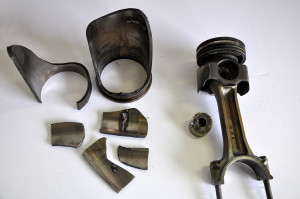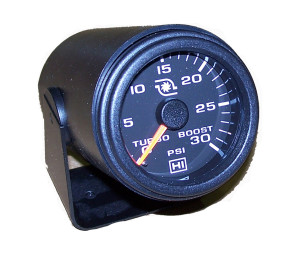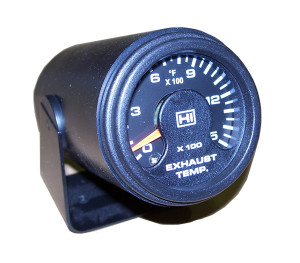 We are seeing a lot of broken pistons and cracked heads on the newer electronic diesel engines because too many ECM tuners do not understand the internal workings of turbocharged diesel engines. The largest culprit for these failures seems to be engines with the timing advanced too far forward. Timing should never be advanced on any engine that is turbocharged, supercharged or equipped with a blower. It doesn’t matter what the fuel is – gas, alcohol, nitro or diesel – timing should not be advanced once the air is forced into the combustion chamber.
We are seeing a lot of broken pistons and cracked heads on the newer electronic diesel engines because too many ECM tuners do not understand the internal workings of turbocharged diesel engines. The largest culprit for these failures seems to be engines with the timing advanced too far forward. Timing should never be advanced on any engine that is turbocharged, supercharged or equipped with a blower. It doesn’t matter what the fuel is – gas, alcohol, nitro or diesel – timing should not be advanced once the air is forced into the combustion chamber.
If you allow a truck stop tuner (or anyone that says they can increase your power or improve your fuel mileage by tuning your ECM) to work on your rig without fully understanding the effects of advanced timing, your engine is at risk of breaking pistons and cracking heads. If you go back and read my articles about Big Cam Cummins engines that used aluminum pistons, you will see that we retarded the timing as horsepower increased to decrease internal pressure and eliminate rattle when accelerating.
Let’s talk about the ISX Cummins engines. The 1998 through 2002 non-EGR engine was a CM570. The CM stood for Control Module and the 570 denoted the engine family. The ECM on this engine had 6,400 parameters, which is more than the space shuttle had. From 2003 to 2007 was the CM870 engine, which was equipped with EGR (exhaust gas recirculation), and then in 2008 this EGR engine was also equipped with a DPF (diesel particulate filter), which was called the CM871 engine, and used through 2011. In 2012, the common rail fuel system and DEF (Diesel Exhaust Fluid) were added to the DPF and EGR, and that engine was known as the CM2250, which ran through 2013. In 2014, the CM2350 was introduced, and it’s ECM has just over 17,000 parameters that can be changed! This ECM is still being used today.
 The latest offering from Cummins is the X-15 ISX engine, known as the CM2350X15. For this engine, Cummins eliminated the 7th injector, which was used in previous models to regen the DPF, and switched the regen responsibilities to injectors #3 and #4 by injecting more fuel during valve overlap to make the heat to perform the regen. The CM2350 has a total of 45 variable timing tables: 15 timing tables for the pre-injection; 15 for the main fuel injection; and 15 for the post-injection. Now, take 15 times 15 times 15 (or 15 to the third power) and do the math – this engine has 3,375 different timing tables! Be careful who you let make changes to your ECM, because the un-informed mechanic or tuner could really screw this up. This X-15 engine is an engineering marvel – it is so smooth, you will think you have a General Electric motor under the hood.
The latest offering from Cummins is the X-15 ISX engine, known as the CM2350X15. For this engine, Cummins eliminated the 7th injector, which was used in previous models to regen the DPF, and switched the regen responsibilities to injectors #3 and #4 by injecting more fuel during valve overlap to make the heat to perform the regen. The CM2350 has a total of 45 variable timing tables: 15 timing tables for the pre-injection; 15 for the main fuel injection; and 15 for the post-injection. Now, take 15 times 15 times 15 (or 15 to the third power) and do the math – this engine has 3,375 different timing tables! Be careful who you let make changes to your ECM, because the un-informed mechanic or tuner could really screw this up. This X-15 engine is an engineering marvel – it is so smooth, you will think you have a General Electric motor under the hood.
If you think this new Cummins engine is complicated, look out, because Detroit, Mack, Volvo and Paccar are all making similar changes. Think about this the next time you allow an unqualified mechanic or tuner to plug into your ECM. If he/she does not entirely understand the internal workings of your complex engine, you may be replacing pistons or your cylinder head within the next year or two. The steel top pistons in today’s engines are very strong, but advanced timing can fatigue the metal and bore a hole through them and/or cause the head to crack. We have also seen premature rod bearing failures because the internal pressures are greater than the film strength of the oil. Advanced timing raises internal pressures well beyond the manufacturers’ recommendations. I had the privilege of learning this from Mark Chapple, a performance parts engineer at the Cummins engine plant in Columbus, IN back in 1983. Mark invited me to join him at the engine facility many times throughout the years to work on various projects, and I was always all ears, listening and learning, from the various engineers. Mark Chapple and Pittsburgh Power continue to work together today, in our engineering facility.
 Are you committing diesel engine suicide? If your truck is NOT equipped with a working pyrometer (exhaust gas temperature gauge) and turbo boost gauge (manifold pressure), you should NOT be driving it. I don’t care if you have been driving for 35 years, you cannot tell how hot the exhaust gas temperature is or if the engine has a turbo boost leak. You may hear a very large boost leak if the radio is turned down and there is not a lot of traffic around you, but most of the time you will not hear it. Most trucks today do not have a spot mirror on the top of their mirror braces, so you can’t see the stack to see what type of smoke is coming out. The pyrometer and turbo boost gauge will give you the information you need, if you know how to read them. If you don’t, I will teach you while you are driving your truck (if you are a client of ours).
Are you committing diesel engine suicide? If your truck is NOT equipped with a working pyrometer (exhaust gas temperature gauge) and turbo boost gauge (manifold pressure), you should NOT be driving it. I don’t care if you have been driving for 35 years, you cannot tell how hot the exhaust gas temperature is or if the engine has a turbo boost leak. You may hear a very large boost leak if the radio is turned down and there is not a lot of traffic around you, but most of the time you will not hear it. Most trucks today do not have a spot mirror on the top of their mirror braces, so you can’t see the stack to see what type of smoke is coming out. The pyrometer and turbo boost gauge will give you the information you need, if you know how to read them. If you don’t, I will teach you while you are driving your truck (if you are a client of ours).
You should always know about where these two important gauges are reading before you look at them. If you don’t, you are not driving your truck properly. By knowing what they should be reading, you will be able to tell if you have a loss of turbo boost or a loss of fuel flow. If the exhaust temperature is higher than normal and the boost is lower than normal, the air intake system, air filter or turbocharger have a problem or leak. If the boost is low and the exhaust gas temperature is low, the engine is suffering from a fuel delivery problem or ECM calibration problem. When we get the phone call and you tell us you have poor fuel mileage and low power and want to know what is wrong, and we ask you about the readings on the pyrometer and boost gauge and you tell us you do not have them, we cannot help you over the phone. At that point, all we can do is tell you to make an appointment and bring it to our shop. The boost gauge kit is $70 and the pyrometer kit is $178, and you can install both of them in your driveway or a truck stop parking lot if you have some tools.
Now, let’s talk about something fun! This year’s annual Owner Operator Snowmobile Conference is being held on January 25-28 at the Horseshoe Mountain Lodge in Mt. Pleasant, UT (435-462-9330). There are rooms reserved under “Pittsburgh Power Snowmobile Group” and the price for a room with one king bed is $75 per night and with two queen beds is $80 per night. We will meet there on Thursday the 25th and ride the Skyline Drive on Friday, Saturday and Sunday. Sherman Zeeman, a retired heavy-hauler and owner operator from Payson, Utah, will be the principal speaker. The title of his speech will be “Trucking the Old School Way with Gasoline Engines Pulling Soldiers Summit at 3 mph” (Sherman is the owner of the very first double-bunk 1975 W900 Kenworth ever built). George Gallamore from the CMC will also speak on Saturday night about negotiations and dealing with people.
Rental snowmobiles are available at Big Pine Sports in Fairview, UT (435-427-3338). They also rent trailers, however we will have to figure out how you will tow the trailer if you fly into Salt Lake City. We will be having two Owner Operator Snowmobile Conferences this year – the next one will be at the end of February or the first weekend of March. If you have never joined us, you are missing the opportunity of a lifetime to share time with other owner operators while playing in the warm snow, under blue skies, and tearing up the mountains on 165-hp snowmobiles that will accelerate to 60 mph in under four seconds. For more details about the conference or our products, call Pittsburgh Power in Saxonburg, PA at (724) 360-4080 or visit www.pittsburghpower.com today.

1 Comment
I had a chance to read your article on ECM tuning and performance enhancements, and it’s a fantastic resource for truck enthusiasts and those looking to maximize their vehicle’s capabilities. Your detailed explanation of ECM tuning, its benefits, and the potential for optimizing engine performance is both informative and engaging. I appreciate the emphasis on working with experienced professionals to ensure safe and effective tuning. This article serves as a valuable guide for truck owners looking to achieve better fuel efficiency and overall performance, and I’m sure it will be a go-to reference for anyone considering ECM tuning.